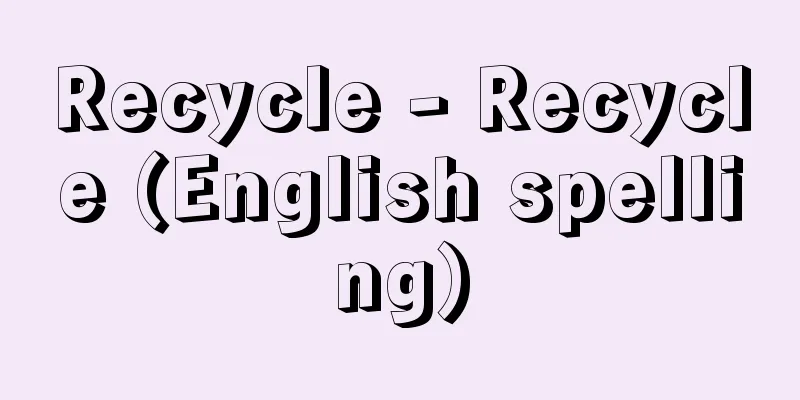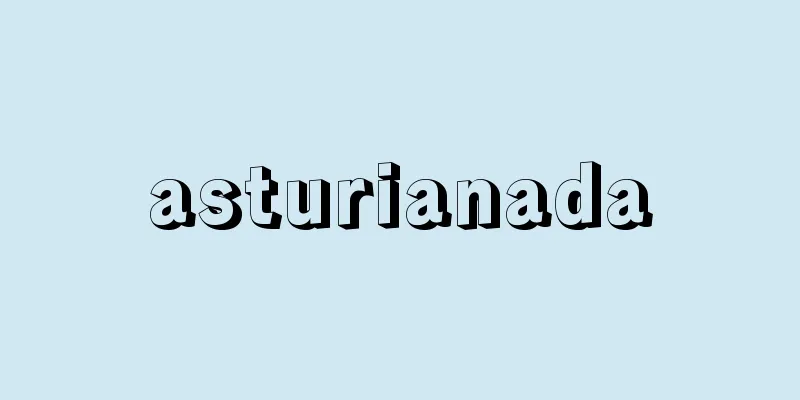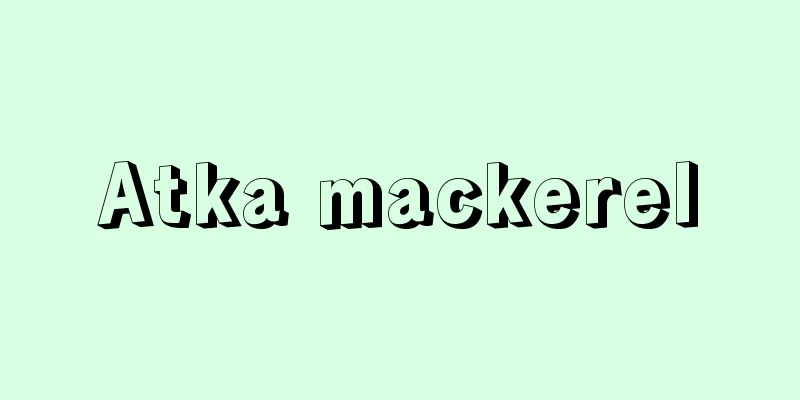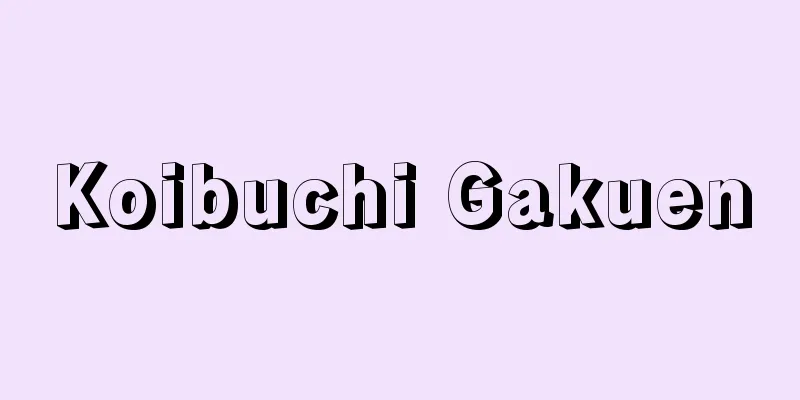Recycle - Recycle (English spelling)

|
Recycling is the process of effectively using unneeded materials generated in daily life and by-products of industrial activities by recycling them as resources or recovering and recycling valuable materials. Examples of recycling include making recycled paper from paper waste and collecting empty cans and reusing them as cans again. [Masaru Tanaka] Collective CollectionAs an alternative to separate collection by municipalities, citizen groups often undertake voluntary resource collection activities. Resource collection by such volunteer groups (local groups, PTAs, children's groups, senior citizens' groups, etc.) is called "collective collection." In these collections, recyclable resources such as newspapers, magazines, and aluminum cans are collected, and the income earned is used as activity funds for the group. Many municipalities also support independent citizen activities by offering incentives according to the amount of recyclable waste collected through collective collection. [Masaru Tanaka] Recycling StatusIn Japan, resource recovery by retailers at the distribution stage has played a major role. Representative examples include glass bottles and button-type batteries. Collection and recycling companies also play a major role in recycling. Examples include the collection of waste paper and used textiles. Nowadays, many local governments are separating recyclable waste and collecting it separately, and citizens are separating recyclable items from other waste and disposing of them, recycling resources efficiently. Among items discarded from households, recycling is progressing for waste paper, glass bottles, aluminum cans, steel cans, and PET bottles. The amount of waste recycled through separate collection and intermediate processing in municipalities was 6.7 million tons, while the amount of waste collected collectively by residents' groups was 2.8 million tons. The combined recycling rate for both was approximately 21%, and is increasing year by year (FY2009). In Japan, various policies are in place to set high targets for utilization and recycling rates for individual items, promoting waste reduction and recycling. Some local governments have set up recycling centers as places where citizens can exchange unwanted items or hold bazaars. These recycling centers provide equipment and facilities that allow citizens to repair and recycle unwanted items themselves, and use these facilities as a base to raise awareness of resource conservation and environmental protection, promoting waste reduction and recycling. A few local governments have also introduced a deposit system (a system in which a collection deposit is added to the sale and returned when empty containers are brought in). The recycling rates by item are 97% for glass bottles (cullet usage/glass bottle production. Cullet is glass bottles that have been crushed into small pieces and processed to be used as the raw material for bottles), 89% for steel cans (weight recycled/weight consumed), 93% for aluminum cans (weight recycled/weight consumed), and 51% for PET bottles (amount sorted and collected/production) (2009), and are increasing year by year. As for the utilization of waste heat from incineration facilities, in 2009 there were 727 facilities that used hot water, 238 facilities that used steam, and 301 facilities that generated electricity, with many facilities using waste heat (data source: 2011 Environmental White Paper). [Masaru Tanaka] Recycling ChallengesCitizens' interest in environmental and resource issues has grown, and the amount of recyclable waste collected by citizen groups has increased sharply. As a result, the supply of recyclable waste exceeds the demand, and collected items cannot be sold, resulting in a phenomenon in which people have to pay a collection fee for magazines, glass bottles, and other items. As a result, there have been reported cases in which some of the collected recyclable waste is disposed of as waste without being used effectively. In order to make sustainable use of finite resources into the future, it is essential to increase the demand for recyclable waste. In order to make effective use of recyclable waste, it will be necessary to build and improve a recycling system that takes into account various factors such as economic efficiency. [Masaru Tanaka] Recycling LawThe Act on Promotion of Utilization of Recyclable Resources (commonly known as the Recycling Act), which stipulates measures to promote recycling with the aim of effective resource utilization, reducing waste generation, and environmental conservation, came into force in October 1991. It was later amended to the Act on Promotion of Effective Utilization of Resources and came into force in April 2001. This act incorporates the ideas of reduce, reuse, and recycle, and aims to encourage business operators to promote these efforts. [Masaru Tanaka] Containers and Packaging Recycling LawThe Law Concerning Promotion of Separate Collection and Recycling of Containers and Packaging (commonly known as the Container and Packaging Recycling Law) was enacted on June 16, 1995 with the aim of promoting the recycling of containers and packaging, which account for a significant portion of general waste and can be reused as a recyclable resource. The law aims to build a social system in which consumers, municipalities, and businesses each actively work to promote the recycling of containers and packaging by sharing the responsibility for each of them. Consumers are required to cooperate with the separate collection by municipalities (separate disposal), and businesses that use specified containers (containers subject to the recycling obligation), businesses that manufacture or import specified containers, and businesses that use specified packaging (collectively referred to as "specified businesses") are obligated to recycle the container and packaging waste that is collected separately by municipalities in accordance with the amount of use, production, etc. [Masaru Tanaka] Home Appliance Recycling LawThe Specified Household Appliance Recycling Law (commonly known as the Home Appliance Recycling Law), which requires manufacturers to recycle home appliances that are too large or heavy to dispose of, was promulgated on June 5, 1998, and came into effect in April 2001. The law covers four items: televisions (cathode ray tube, liquid crystal, and plasma types), refrigerators/freezers, washing machines/clothes dryers, and air conditioners. Retailers collect waste home appliances from consumers, and ultimately the manufacturers take them back and remanufacture them (recycle them). Consumers are required to pay the costs required for collection and recycling. [Masaru Tanaka] Automobile Recycling LawThe Law on Recycling of End-of-Life Vehicles (commonly known as the Automobile Recycling Law) was promulgated in July 2002 with the aim of promoting the proper disposal, recycling and regeneration of end-of-life vehicles, preserving the environment, and creating a recycling-oriented society. It was implemented in stages and came into full force in January 2005. It stipulates the roles and responsibilities of automobile-related businesses, such as automobile manufacturers, importers, sellers, and dismantlers, in the recycling and proper disposal of end-of-life vehicles, and also requires consumers to pay recycling fees. In particular, it stipulates the proper disposal of three items: shredder dust (crushed automobile scraps), fluorocarbons, and airbags. In addition, the Electronic Manifest System (an information management system using an electronic system) was introduced, and since each end-of-life vehicle is managed consistently on an electronic network, it is expected that illegal dumping will decrease. The recycling fees and electronic manifest are managed by the Automobile Recycling Promotion Center (jointly managed by the Ministry of Economy, Trade and Industry, the Ministry of Land, Infrastructure, Transport and Tourism, and the Ministry of the Environment). [Masaru Tanaka] "Explanation of the Law Concerning the Promotion of Effective Utilization of Resources (Law Concerning the Promotion of Effective Utilization of Resources)" edited by the Recycling Promotion Division, Industrial Technology and Environment Bureau, Ministry of Economy, Trade and Industry (2004, Research Institute of Economy, Trade and Industry)" ▽ "New Introduction to Waste Science" by Masaru Tanaka (2005, Chuohoki Publishing)" ▽ "The Road to a Recycling Society" by Katsumi Yorimoto (Iwanami Shinsho) [Reference items] | | | | | |Source: Shogakukan Encyclopedia Nipponica About Encyclopedia Nipponica Information | Legend |
|
日常生活において発生する不要物や産業活動に伴い副次的に得られた物品を、資源として再生利用、あるいは有価物を回収・再生して有効利用すること。紙ごみから再生紙をつくることや、空き缶を回収し、ふたたび空き缶として再生利用することなどがリサイクルの例としてあげられる。 [田中 勝] 集団回収市町村による分別収集以外の資源回収方法として、市民団体による自主的な資源回収活動がよく実施されている。こうしたボランティア団体(地域団体、PTA、子供会、老人会など)による資源回収を「集団回収」という。こうした回収では、新聞、雑誌、アルミ缶などのリサイクル資源を回収し、得られた収入を団体の活動資金として活用している。また多くの市町村では、集団回収によって回収された資源ごみの量に応じて報奨金を交付して、市民の自主的活動を支援している。 [田中 勝] リサイクルの現状日本のリサイクルでは、小売業者による流通段階での資源回収が大きな役割を果たしてきた。その代表例として、ガラス瓶、ボタン型乾電池などがある。また回収・再生業者の存在もリサイクルに大きな役割を果たしている。その例として古紙や中古繊維の回収などがあげられる。現在では、資源ごみの分別収集を行っている自治体も数多くなり、市民は資源化可能なものを他のごみと分けて排出し、資源化を効率よく行っている。家庭から排出されるもののなかで再資源化が進んでいるのは、古紙、ガラス瓶、アルミ缶、スチール缶、ペットボトルなどである。 市町村において分別収集や中間処理により資源化された量は670万トン、住民団体によって資源回収された集団回収量は280万トン、両者を合わせたリサイクル率は約21%で、年々上昇している(2009年度)。 日本では個々の品目については、いろいろな政策により利用率や再資源化率の目標を高く設定することによって、減量化・資源化を促進している。自治体によっては市民が不要になったものを交換したり、バザーを行ったりする場として、リサイクルセンターを設置しているところもある。このリサイクルセンターでは、不要品を市民自ら修理・再生できるような設備・施設を提供しており、この施設を拠点にして資源保全、環境保護の意識啓発を行い、ごみの減量化・資源化を推進している。また、デポジット制度(販売時に回収保証金を上乗せして、空き容器を持ち込んだときにそれを返却する制度)を導入している自治体もわずかにある。 品目別のリサイクル率は、ガラス瓶が97%(カレット利用量/ガラス瓶生産量。カレットとは、ガラス瓶を細かく砕いて瓶の原料用に加工したもののこと)、スチール缶が89%(再資源化重量/消費重量)、アルミ缶が93%(再資源化重量/消費重量)、ペットボトルが51%(分別収集量/生産量)となっており(2009年度)、年々高まってきている。また焼却施設の余熱利用の状況は、2009年度において温水利用727施設、蒸気利用238施設、発電301施設と、数多くの施設が余熱利用をしている(データ出典は平成23年度環境白書による)。 [田中 勝] リサイクルの課題環境・資源問題に対して市民の関心が高まり、市民団体による資源ごみの回収量が急増している。その結果として、資源ごみの需要に対して供給量が過剰となり、回収物が売却できず、雑誌やガラス瓶などでは引き取り料を支払う逆有償という現象が起きている。これにより回収された資源ごみの一部が有効に利用されることなく廃棄物として処分される例も報告されている。有限な資源を将来にわたって持続的に利用していくためには、資源ごみの需要の拡大は必須(ひっす)であり、資源ごみの有効利用に向け、今後は経済性など種々の要因を考慮にいれたうえで、リサイクルシステムを構築し、充実させていく必要があろう。 [田中 勝] リサイクル法資源の有効利用、廃棄物の発生抑制および環境の保全を目的として、リサイクルを促進するための措置を定めた「再生資源の利用の促進に関する法律」(通称、リサイクル法)が、1991年(平成3)10月より施行された。その後、「資源の有効な利用の促進に関する法律」に改正され、2001年(平成13)4月に施行された。本法は、リデュース(発生抑制)、リユース(再使用)、リサイクル(再生利用)の考え方を取り入れ、事業者がこれらの取り組みを進めることを目的としている。 [田中 勝] 容器包装リサイクル法一般廃棄物のなかで相当部分を占め、再生資源としての利用が可能な容器包装についてリサイクルを促進することを目的とする「容器包装に係る分別収集及び再商品化の促進等に関する法律」(通称、容器包装リサイクル法)が、1995年(平成7)6月16日制定された。同法は容器包装について、消費者、市町村、事業者のそれぞれが責任を分担することにより、それぞれが容器包装のリサイクル推進に積極的に取り組む社会システムの構築を目ざすものである。消費者については、市町村が行う分別収集に協力(分別排出)すること、また、特定容器(再商品化義務の対象となる容器)を利用する事業者、特定容器を製造または輸入する事業者および特定包装を利用する事業者(これらを「特定事業者」という)は、市町村が分別収集した容器包装廃棄物を、その使用量や製造量等に応じて、再商品化を行う義務を負うこととなっている。 [田中 勝] 家電リサイクル法大きすぎたり重すぎたりして処理が困難な家電製品のリサイクルをメーカーに義務づける「特定家庭用機器再商品化法」(通称、家電リサイクル法)が、1998年(平成10)6月5日に公布され、2001年(平成13)4月に施行された。テレビ(ブラウン管式、液晶・プラズマ式)、冷蔵庫・冷凍庫、洗濯機・衣類乾燥機、エアコンの4品目が対象となった。小売業者は消費者から廃家電を引き取り、最終的に製造業者が引き取り・再商品化(リサイクル)を実施する。なお、消費者は収集およびリサイクルに必要な費用を支払うこととなっている。 [田中 勝] 自動車リサイクル法使用済自動車の適正処理とリサイクルおよび再資源化を推進し、環境を保全、循環型社会をつくることを目的として「使用済自動車の再資源化等に関する法律」(通称、自動車リサイクル法)が、2002年(平成14)7月に公布され、段階的な施行を経て2005年1月に完全施行となった。使用済自動車のリサイクルと適正処理において、自動車メーカー、輸入業者、販売者、解体業者など自動車関係業者の役割と義務を定め、また消費者にもリサイクル料金の支払いを義務づけている。とくにシュレッダーダスト(自動車粉砕くず)、フロン類、エアバッグ類、という3品目について、適正処理を定めている。また、電子マニフェスト制度(電子システムによる情報管理制度)が導入され、使用済自動車が1台ずつ一貫して電子ネットワーク上で管理されるため、不法投棄の減少が期待される。リサイクル料金と電子マニフェストの管理は、「公益財団法人自動車リサイクル促進センター」(経済産業省、国土交通省、環境省共管)が行う。 [田中 勝] 『経済産業省産業技術環境局リサイクル推進課編『資源有効利用促進法(資源の有効な利用の促進に関する法律)の解説』(2004・経済産業調査会)』▽『田中勝著『新・廃棄物学入門』(2005・中央法規出版)』▽『寄本勝美著『リサイクル社会への道』(岩波新書)』 [参照項目] | | | | | |出典 小学館 日本大百科全書(ニッポニカ)日本大百科全書(ニッポニカ)について 情報 | 凡例 |
Recommend
Acridotheres
...Their songs are not well developed, but they h...
Mir Wais
? ‐1715 Hotaki, chief of the Ghilzai Pashtun tribe...
Daimoku Dance - Daimoku Dance
〘Noun〙 A dance performed on the night of the 16th ...
Parallelogram - Parallelogram (English spelling)
A quadrilateral with two pairs of opposite sides t...
Santama
The name of the western half of Tokyo (excluding ...
Fumio Goto
Home Ministry bureaucrat and politician. Born in ...
Reduction blowing - Kangenbuki
…The ore used in copper smelting often contains c...
Setiabudi, D. (English spelling) SetiabudiD
…Leader of the Indonesian nationalist movement. L...
Equus kiang (English spelling)
Perissodactyla, Equidae. A wild donkey also known ...
Christensen, B.
...On the other hand, the emerging Swedish film i...
Miirotateha (three-colored moth) - Miirotateha
A general term for insects of the Agrias genus in ...
Benelux Customs Union (English)
…the collective name for the three supranational ...
Plantijn, C. (English spelling) PlantijnC
…French-born Dutch printer and publisher of the R...
Min'yakuyakukai - Min'yakuyakukai
This is a work by Nakae Chomin. It is a translati...
Cooking table - Kansho
…On the other hand, the “hu fu” (bed) seen in Han...









![Muraoka [town] - Muraoka](/upload/images/67ccfc8ed85b0.webp)